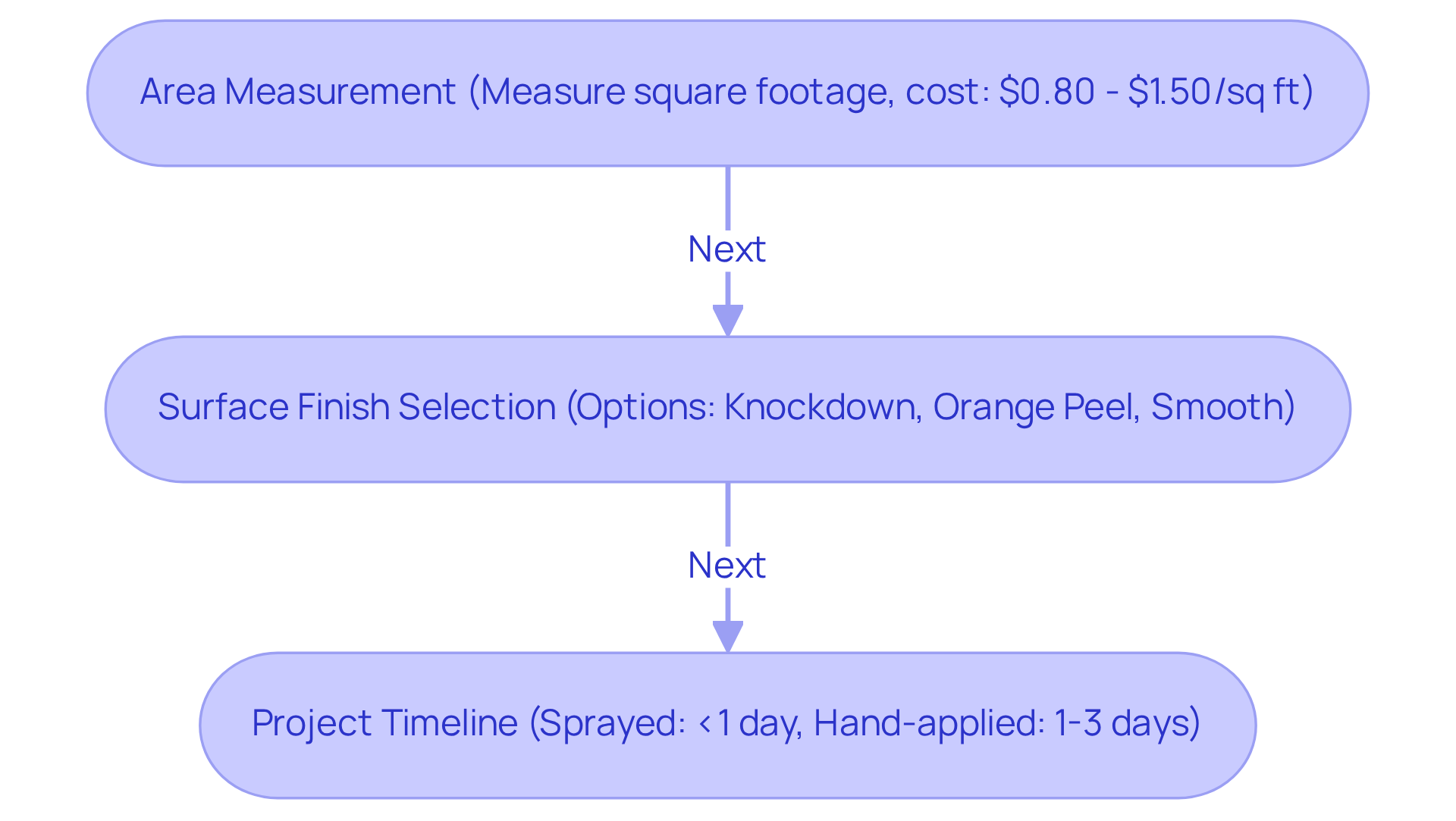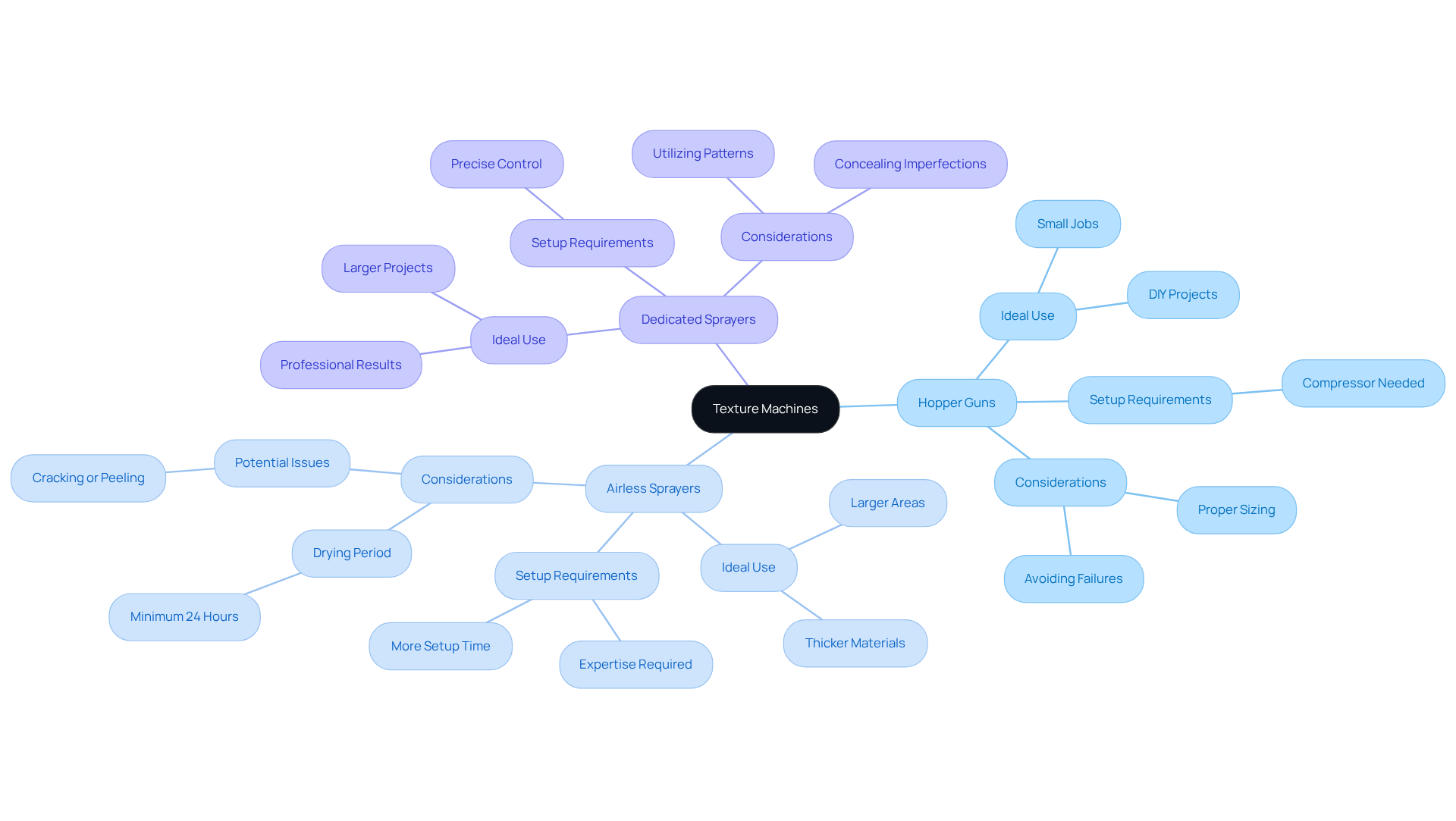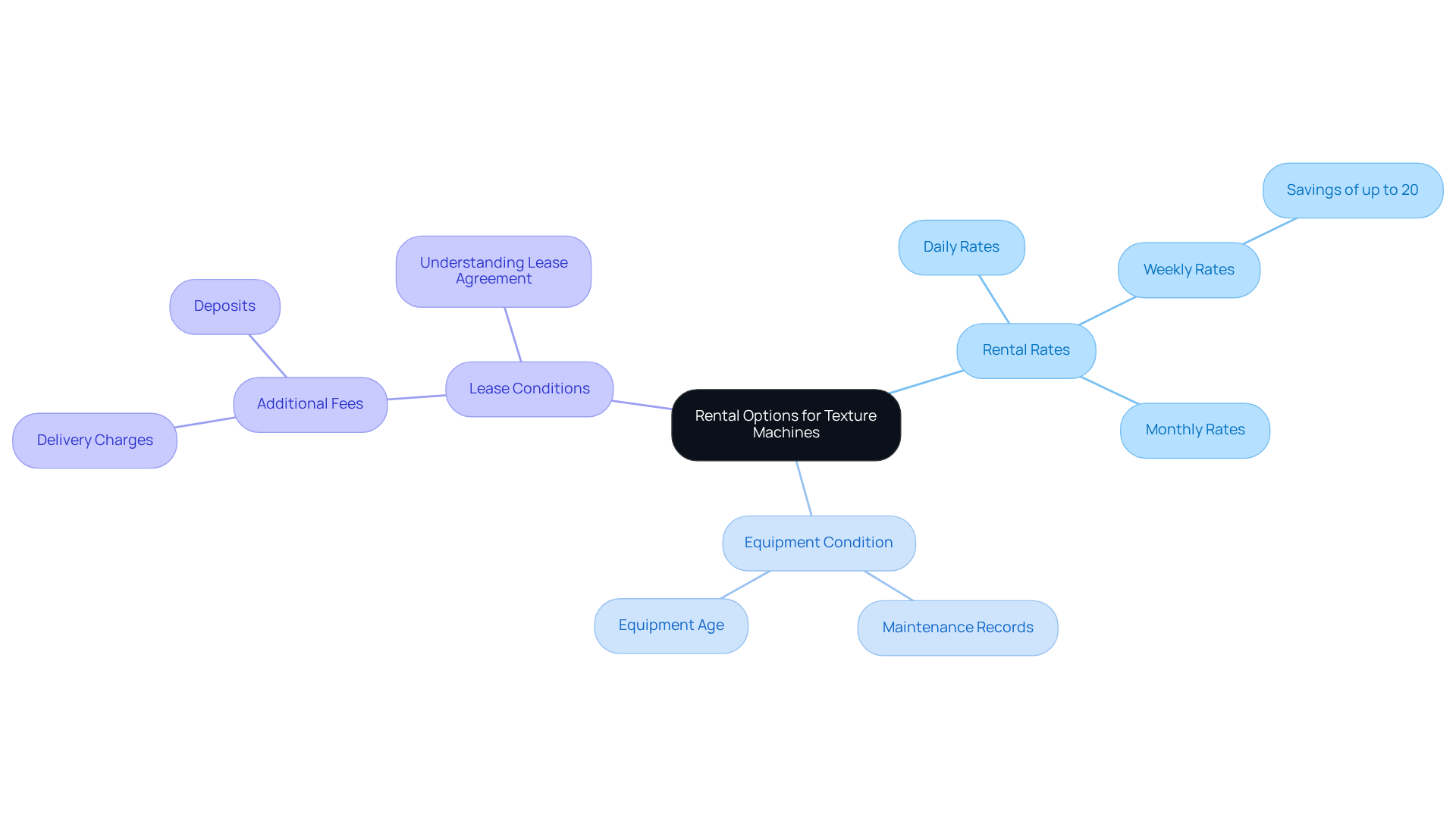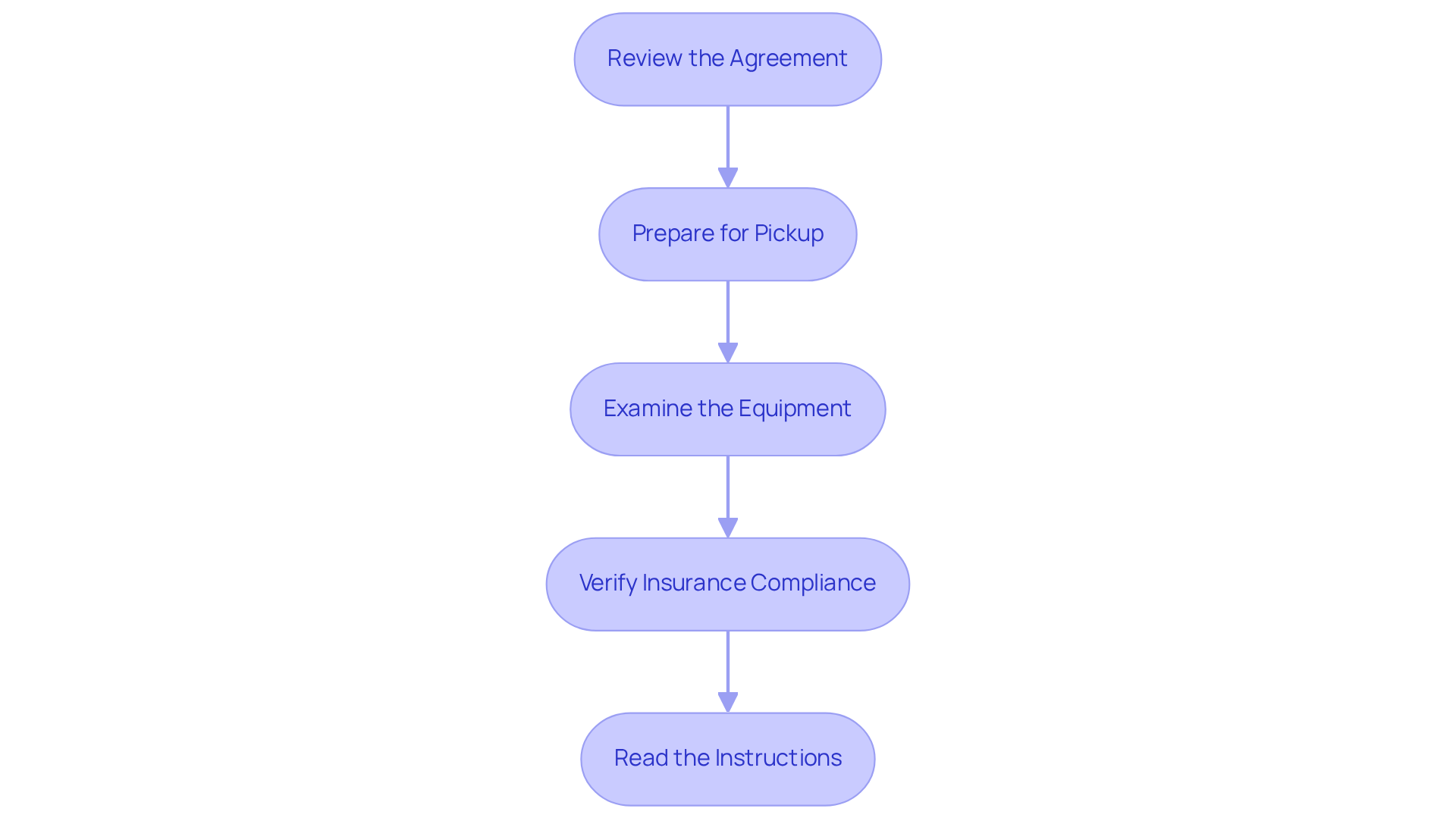Overview
To secure a texture machine rental near you, it is essential to follow four key steps:
- Measure the area to determine your material needs accurately.
- Select the appropriate machine based on your project size and finish type.
- Compare rental options and pricing to find the best fit for your budget.
- Finalize your rental agreement while ensuring equipment readiness.
Each of these steps is crucial; accurate measurements directly impact material costs, choosing the right machine enhances project efficiency, and understanding lease terms prevents future complications.
Key Highlights:
- Accurately measure the area needing texturing to determine material quantity and cost, which ranges from $0.80 to $1.50 per square foot.
- Choose a surface finish type such as knockdown, orange peel, or smooth, each with distinct aesthetics and application methods.
- Establish a project timeline; sprayed applications take less than a day, while hand-applied finishes may require 1 to 3 days.
- Select the appropriate texture machine: hopper guns for small jobs, airless sprayers for larger areas, and dedicated sprayers for professional results.
- Evaluate rental options by comparing daily, weekly, and monthly rates, noting that longer leases can yield savings of up to 20%.
- Ensure equipment condition is optimal by checking maintenance records and the age of the machines.
- Review lease agreements carefully to avoid unexpected costs and ensure clarity on terms regarding damage and insurance.
- Prepare for pickup by arranging transportation and examining the equipment for pre-existing damage before leaving the rental site.
- Verify insurance compliance as per the rental agreement to protect against liabilities.
- Familiarise yourself with the operation manual and safety guidelines to ensure safe and effective use of the rented machine.
Introduction
Navigating the world of equipment rentals can often feel overwhelming, particularly when it comes to specialized tools such as texture machines. However, with the right approach, this process can be simplified, ensuring that projects are executed smoothly and efficiently. This guide explores four essential steps to secure the perfect texture machine rental, offering valuable insights into:
- Project requirements
- Machine selection
- Pricing comparisons
- Finalizing agreements
Furthermore, how can one ensure they are making the best choice without falling into common pitfalls that could lead to costly delays or subpar results?
Understand Your Project Requirements
Begin by thoroughly assessing the scope of your project. Consider the following key points:
- Area Measurement: Identify the specific area that requires texturing and measure the square footage accurately. This measurement is vital as it dictates the quantity of material required, which can vary from $0.80 to $1.50 per square foot for sprayed finishes.
- Surface Finish Selection: Choose the kind of surface finish you wish. Common options include knockdown, orange peel, and smooth finishes, each offering unique aesthetic qualities and application methods.
- Project Timeline: Establish your timeline for completion. Understanding how quickly you need to finish the project will guide you in selecting the appropriate rental duration. Sprayed surface applications usually take under a day, whereas hand-applied finishes might need 1 to 3 days, based on the complexity and team size.
Document these requirements to refer back to when selecting a texture machine rental near me. As Josh Nickell emphasizes, effective planning and analytics are essential in equipment leasing to avoid guesswork. This organized method not only simplifies the process of texture machine rental near me but also guarantees that you have the appropriate equipment to satisfy your task's specific requirements.

Identify the Right Type of Texture Machine
Understanding your assignment needs is crucial when selecting the right machine for various surfaces. Here’s a comprehensive overview of the available options:
- Hopper Guns: Ideal for smaller jobs, these machines can be easily operated with a compressor. Their versatility and ease of use make them a preferred choice for DIY enthusiasts and minor tasks. However, ensuring that the equipment is appropriately sized for the job is essential to avoid poor production rates and potential component failures.
- Airless Sprayers: Best suited for larger areas, airless sprayers provide a smooth finish and can accommodate thicker materials. While they require more setup time and expertise to operate effectively, it is vital for managers to consider the drying period for spray applications, typically necessitating a minimum of 24 hours before painting to prevent issues such as cracking or peeling.
- Dedicated Sprayers for Coating: Specifically designed for surfacing, these devices offer precise control over application, making them the top choice for professional results in larger projects. Utilizing patterns can help conceal imperfections in walls and enhance depth, significantly improving the overall aesthetic of the area.
When selecting a device, consider the scale of your project, the desired finish, and the available power source options, including petrol-powered, electric, or air-powered solutions. Industry professionals emphasize that choosing the right equipment can greatly influence productivity and the overall quality of the work. Properly assessing your needs will help avoid costly mistakes and ensure optimal results. As experts highlight, understanding job requirements is vital to prevent over-buying or under-buying equipment, which can lead to inefficiencies.

Compare Rental Options and Pricing
When evaluating leasing options, it is essential to gather quotes from various leasing companies for texture machine rental near me to make an informed decision. Key factors to consider include:
-
Rental Rates: Analyze daily, weekly, and monthly rates. Numerous businesses provide reductions for prolonged lease durations, significantly lowering expenses for texture machine rental near me. Statistics indicate that extended leasing periods frequently result in substantial savings, with some firms noting reductions of up to 20% for weekly agreements compared to daily prices. Planning your leasing timeline accordingly can lead to considerable cost savings.
-
Equipment Condition: It’s vital to verify that the devices are well-maintained and in optimal working order. Inquire about the age of the equipment and request maintenance records to ensure reliability. A case study on texture machine rental near me emphasizes that well-maintained machines contribute to better project outcomes, as they reduce the risk of breakdowns and delays.
-
Lease Conditions: Carefully review the lease agreement for any additional fees, such as delivery charges or deposits. Understanding the terms regarding damage and insurance is crucial to avoid unexpected costs. A statement from a leasing company underscores this importance: "Ensuring clarity in leasing terms can prevent misunderstandings and extra costs in the future."
Developing a comparison chart based on these factors can assist in simplifying your decision-making process, ensuring you choose the best option for texture machine rental near me to meet your requirements.

Finalize Your Rental Agreement and Prepare for Use
Once you’ve selected a rental company, it’s time to finalize your rental agreement.
-
Review the Agreement: Ensure that all terms are clear, including rental duration, costs, and responsibilities for damages. Notably, over 60% of construction supervisors admit to not adequately examining rental contracts, which can lead to costly misunderstandings and delays in work. Taking the time to review these details can save you from significant issues down the line.
-
Prepare for Pickup: If necessary, arrange for transportation to pick up the texture machine rental near me, ensuring your vehicle can accommodate its size and weight. This preparation is essential, as approximately 70% of construction projects in 2025 are expected to utilize leased tools, underscoring the importance of efficient logistics in your planning.
-
Examine the Equipment: Before leaving the leasing site, carefully check the device for any pre-existing damage and confirm that all essential accessories are included. Document any issues you find to avoid liability for damages that were not your responsibility, ensuring a smooth rental experience.
-
Verify Insurance Compliance: Confirm that you possess the necessary insurance coverage as stipulated in the rental agreement. This step is crucial for protecting yourself against potential liabilities, providing peace of mind as you proceed with your project.
-
Read the Instructions: Familiarize yourself with the operation manual and safety guidelines for the texture machine rental near me to ensure safe and effective use. Understanding these instructions is vital, as improper operation can lead to safety hazards and legal liabilities.
By diligently following these steps, you will be well-prepared to embark on your texturing project with confidence and efficiency.

Conclusion
Securing a texture machine rental is paramount for the successful completion of any texturing project. By adopting a structured approach, individuals can select equipment that meets their specific needs, maximizing efficiency while minimizing costs.
This article delineates four essential steps:
- Assessing project requirements
- Identifying the appropriate type of texture machine
- Comparing rental options and pricing
- Finalizing the rental agreement
Each step underscores the significance of thorough planning, from measuring the area and selecting the surface finish to comprehending rental terms and preparing for equipment use. By meticulously attending to these details, renters can sidestep common pitfalls and ensure a seamless rental experience.
The importance of careful preparation cannot be overstated. Whether for a DIY project or a professional endeavor, investing time to understand needs and compare options will yield superior results and cost savings. As the construction industry increasingly depends on rented equipment, embracing these best practices will not only enhance project outcomes but also foster a more efficient workflow.
Frequently Asked Questions
What is the first step in understanding project requirements for texturing?
The first step is to thoroughly assess the scope of your project, which includes identifying the specific area that requires texturing and measuring the square footage accurately.
Why is area measurement important in a texturing project?
Area measurement is vital as it dictates the quantity of material required for the project, which can vary in cost from $0.80 to $1.50 per square foot for sprayed finishes.
What are some common surface finish options for texturing?
Common surface finish options include knockdown, orange peel, and smooth finishes, each offering unique aesthetic qualities and application methods.
How does the project timeline affect the texturing process?
Establishing a project timeline helps determine how quickly the project needs to be completed, which guides the selection of the appropriate rental duration. Sprayed surface applications usually take under a day, while hand-applied finishes may require 1 to 3 days, depending on complexity and team size.
What should be documented when planning a texturing project?
It is important to document the project requirements, including area measurements, surface finish selections, and project timelines, to refer back to when selecting a texture machine rental.
What does Josh Nickell emphasize about equipment leasing for texturing?
Josh Nickell emphasizes that effective planning and analytics are essential in equipment leasing to avoid guesswork, ensuring that you have the appropriate equipment to meet your project's specific requirements.




